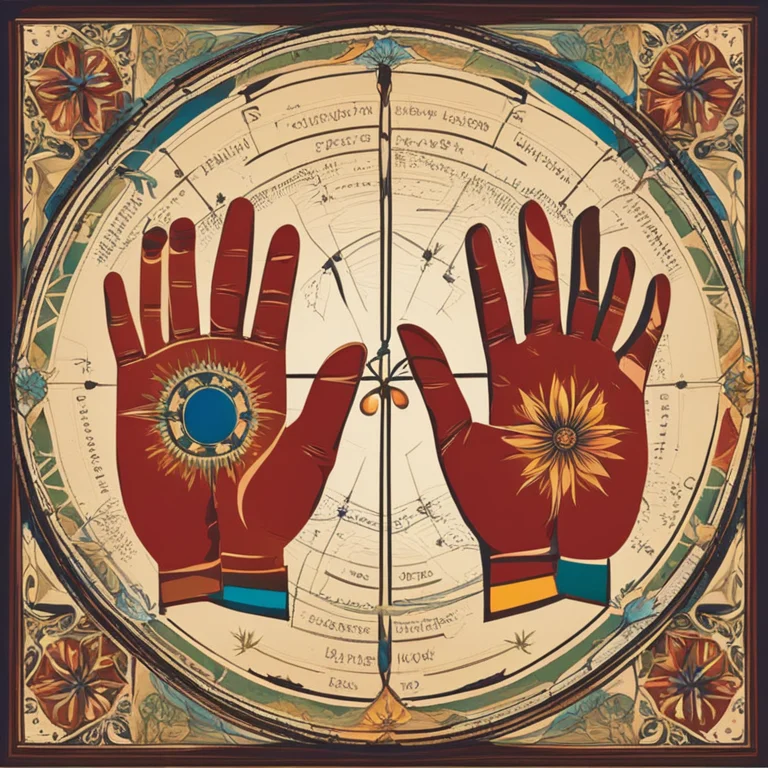
The Essentials of Palmistry: Which Hand to Read?
Delve into the art of palmistry and learn the nuances of choosing the correct hand for a meaningful and accurate reading.
article by Nora Pennington
Palmistry Basics: An Introduction
As a time-honored practice, palmistry has intrigued individuals worldwide since ancient times. It's a form of divination that interprets one's character and foretells their future by analyzing the lines, shapes, and features of the hands. For enthusiasts and professionals alike, the choice of which hand to read presents the first, yet most critical, step in the palmistry process. This decision not only sets the stage for the reading but also impacts the depth and relevance of the insights uncovered. As we dive deeper into the realm of palmistry, let's explore the guidelines and considerations that influence the selection of the hand for an enlightening palm reading experience.

Right Hand vs. Left Hand: Traditional Perspectives
Traditionally in palmistry, each hand is believed to carry its unique significance. The left hand is generally regarded as the 'birth hand,' revealing the raw, unaltered traits and potential gifted to an individual from birth. On the other hand, the right hand typically represents how these innate characteristics have been sculpted by the life experiences one has encountered. It acts as a canvas, showing the impact of one's choices and the external world. Some palmists suggest that for right-handed individuals, the right hand is the one to observe for readings relating to adulthood, while the left hand holds the keys to childhood and latent potential.

Considering Ambidextrous and Left-Handed Clients
In cases where a person is left-handed or ambidextrous, the roles of the hands are thought to be reversed from the standard paradigm. Here, the dominant hand (left, for left-handed individuals) would be read to gain insights into their current life path and experiences, while the non-dominant hand (right) would offer a glimpse into their potential and subliminal traits. It's essential to inquire about your client's dominant hand before the reading commences to ensure an accurate and reflective interpretation.

Modern Adaptations in Palmistry
In the contemporary sphere of palmistry, there's a growing consensus that the binary approach to hand selection is not rigid. Some modern palmists advocate for a more fluid and customized interpretation, suggesting that both hands should be considered in a reading. The interplay between both hands can illuminate a more complete narrative of an individual's past, present, and potential. This holistic examination allows for a nuanced analysis that respects the dynamic nature of one's life story and personal growth.

Cultural Considerations and Global Practices
It's important to note that palmistry is a global art with cultural variations affecting interpretations and practices. In some Eastern traditions, the left hand may be more closely associated with men and the right hand with women when determining which hand to read. Furthermore, cultural lore and local customs often bring additional layers of meaning to the choice of hand, showcasing the rich diversity inherent in the practice of palmistry around the world.
Palmistry for Self-Reflection
For those who turn to palmistry for self-reflection rather than prediction, the decision regarding which hand to read may be more personal. Individuals might be drawn to a particular hand due to a noticeable change in their lines or when facing a significant life event. In self-directed readings, the choice can also be influenced by intuition—a hand might simply 'feel' more relevant at a certain point in time, providing valuable introspection tailored to current personal circumstances or questions.
Final Considerations in Palm Selection
To sum up, choosing which hand to read in palmistry is nuanced and can be influenced by a variety of factors, including traditional methods, individual dominance, modern theories, cultural influences, and personal intuition. A thorough palmist may read both hands to gain the fullest understanding of their client. As we move forward into 2024 and beyond, palmistry continues to evolve, embracing both its ancient roots and the breadth of contemporary perspectives.
Published: 1/11/2024
Modified: 1/11/2024
More predictions
Come back here soon to learn more about yourself and your future


Palm Lines: A Guide to Your Hands' Secrets
Learn the art of reading palm lines with our straightforward guide. Discover what your hands reveal about your personality, destiny, and life!


Jupiter Mount & Palmistry:Exploring The Significance
Delve into the secrets of the Jupiter mount on your palm and discover how it reflects your leadership and ambition.


The Impact of the Jupiter Mount in Palmistry
Discover the impact of the Jupiter Mount on your life through palm reading. Learn about its meaning and significance in palmistry.